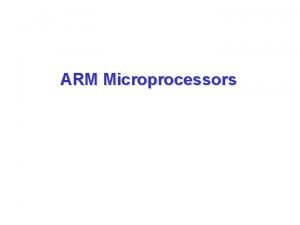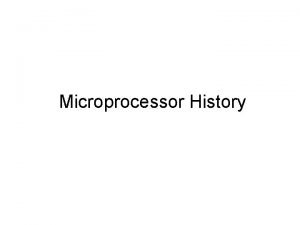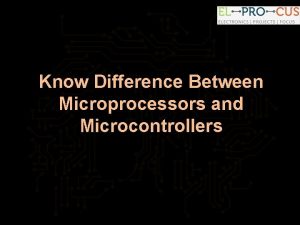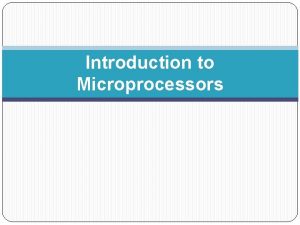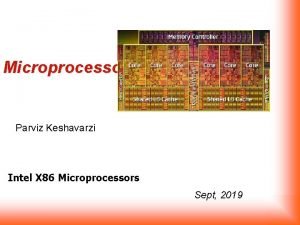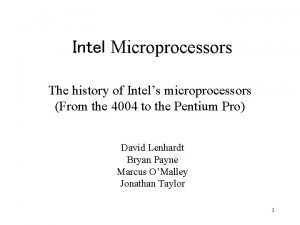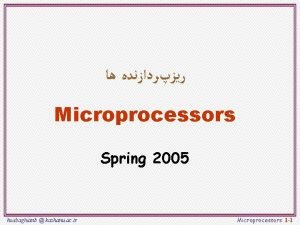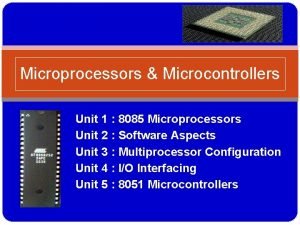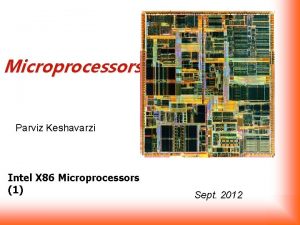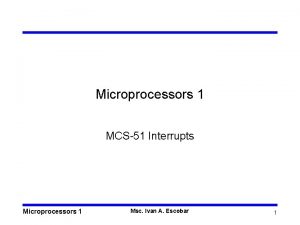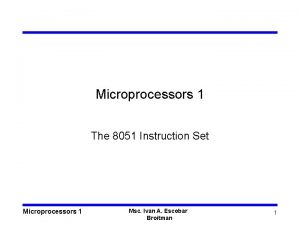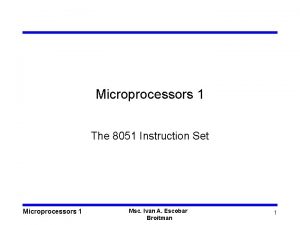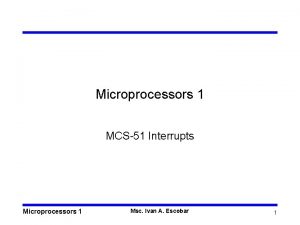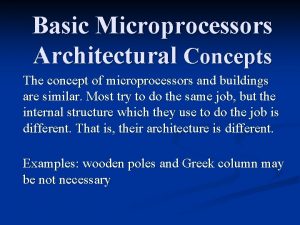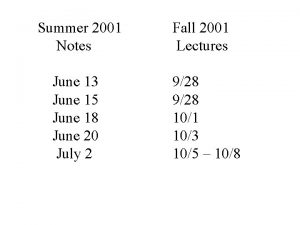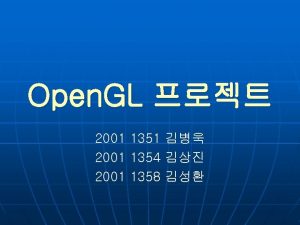Future of Microprocessors June 2001 1 Outline A

















- Slides: 17

Future of Microprocessors June 2001 1

Outline • A 30 year history of microprocessors – Four generation of innovation • High performance microprocessor drivers: – Memory hierarchies – instruction level parallelism (ILP) • Where are we and where are we going? • Focus on desktop/server microprocessors vs. embedded/DSP microprocessor 2

Microprocessor Generations • First generation: 1971 -78 – Behind the power curve (16 -bit, <50 k transistors) • Second Generation: 1979 -85 – Becoming “real” computers (32 -bit , >50 k transistors) • Third Generation: 1985 -89 – Challenging the “establishment” (Reduced Instruction Set Computer/RISC, >100 k transistors) • Fourth Generation: 1990– Architectural and performance leadership (64 -bit, > 1 M transistors, Intel/AMD translate into RISC internally) 3

In the beginning (8 -bit) Intel 4004 • First general-purpose, single • • • chip microprocessor Shipped in 1971 8 -bit architecture, 4 -bit implementation 2, 300 transistors Performance < 0. 1 MIPS (Million Instructions Per Sec) 8008: 8 -bit implementation in 1972 – 3, 500 transistors – First microprocessor-based computer (Micral) • Targeted at laboratory instrumentation • Mostly sold in Europe All chip photos in this talk courtesy of Michael W. Davidson and The Florida State University 4

1 st Generation (16 -bit) Intel 8086 • Introduced in 1978 – Performance < 0. 5 MIPS • New 16 -bit architecture – “Assembly language” – – compatible with 8080 29, 000 transistors Includes memory protection, support for Floating Point coprocessor • In 1981, IBM introduces PC – Based on 8088 --8 -bit bus version of 8086 5

2 nd Generation (32 -bit) Motorola 68000 • Major architectural step in microprocessors: – First 32 -bit architecture • initial 16 -bit implementation – First flat 32 -bit address • Support for paging – General-purpose register architecture • Loosely based on PDP-11 minicomputer • First implementation in 1979 – 68, 000 transistors – < 1 MIPS (Million Instructions • Per Second) Used in – Apple Mac – Sun , Silicon Graphics, & Apollo workstations 6

3 rd Generation: MIPS R 2000 • Several firsts: – First (commercial) RISC – – microprocessor First microprocessor to provide integrated support for instruction & data cache First pipelined microprocessor (sustains 1 instruction/clock) • Implemented in 1985 – 125, 000 transistors – 5 -8 MIPS (Million Instructions per Second) 7

4 th Generation (64 bit) MIPS R 4000 • First 64 -bit architecture • Integrated caches – On-chip – Support for off-chip, secondary cache • Integrated floating point • Implemented in 1991: – – Deep pipeline 1. 4 M transistors Initially 100 MHz > 50 MIPS • Intel translates 80 x 86/ Pentium X instructions into RISC internally 8

Key Architectural Trends • Increase performance at 1. 6 x per year (2 X/1. 5 yr) – True from 1985 -present • Combination of technology and architectural enhancements – Technology provides faster transistors – – ( 1/lithographic feature size) and more of them Faster transistors leads to high clock rates More transistors (“Moore’s Law”): • Architectural ideas turn transistors into performance – Responsible for about half the yearly performance growth • Two key architectural directions – Sophisticated memory hierarchies – Exploiting instruction level parallelism 9

Memory Hierarchies • Caches: hide latency of DRAM and increase BW – CPU-DRAM access gap has grown by a factor of 30 -50! • Trend 1: Increasingly large caches – On-chip: from 128 bytes (1984) to 100, 000+ bytes – Multilevel caches: add another level of caching • First multilevel cache: 1986 • Secondary cache sizes today: 128, 000 B to 16, 000 B • Third level caches: 1998 • Trend 2: Advances in caching techniques: – Reduce or hide cache miss latencies • early restart after cache miss (1992) • nonblocking caches: continue during a cache miss (1994) – Cache aware combos: computers, compilers, code writers • prefetching: instruction to bring data into cache early 10

Exploiting Instruction Level Parallelism (ILP) • ILP is the implicit parallelism among instructions • (programmer not aware) Exploited by – Overlapping execution in a pipeline – Issuing multiple instruction per clock • superscalar: uses dynamic issue decision (HW driven) • VLIW: uses static issue decision (SW driven) • 1985: simple microprocessor pipeline (1 instr/clock) • 1990: first static multiple issue microprocessors • 1995: sophisticated dynamic schemes – determine parallelism dynamically – execute instructions out-of-order – speculative execution depending on branch prediction • “Off-the-shelf” ILP techniques yielded 15 year path of 2 X performance every 1. 5 years => 1000 X faster! 11

Where have all the transistors gone? • Superscalar (multiple instructions per clock cycle) 3 levels of cache • • Branch prediction (predict outcome of decisions) • Out-of-order execution (executing instructions in different order than programmer wrote them) Execution 2 Bus Intf D TLB cache Out-Of-Order branch Icache SS Intel Pentium III (10 M transistors) 12

Deminishing Return On Investment • Until recently: – Microprocessor effective work per clock cycle (instructions – per clock)goes up by ~ square root of number of transistors Microprocessor clock rate goes up as lithographic feature size shrinks • With >4 instructions per clock, microprocessor • performance increases even less efficiently Chip-wide wires no longer scale with technology – They get relatively slower than gates (1/scale)3 – More complicated processors have longer wires 13

Moore’s Law vs. Common Sense? Intel MPU die ~1000 X RISC II die • Scaled 32 -bit, 5 -stage RISC II 1/1000 th of current MPU, die size or transistors (1/4 mm 2 ) 14

New view: Cluster. Ona. Chip (Co. C) • Use several simple processors on a single chip: – Performance goes up linearly in number of transistors – Simpler processors can run at faster clocks – Less design cost/time, Less time to market risk (reuse) • Inspiration: Google – Search engine for world: 100 M/day – Economical, scalable build block: – PC cluster today 8000 PCs, 16000 disks Advantages in fault tolerance, scalability, cost/performance • 32 -bit MPU as the new “Transistor” – “Cluster on a chip” with 1000 s of processors enable amazing – MIPS/$, MIPS/watt for cluster applications MPUs combined with dense memory + system on a chip CAD • 30 years ago Intel 4004 used 2300 transistors: when 2300 32 -bit RISC processors on a single chip? 15

VIRAM-1 Integrated Processor/Memory 15 mm • Microprocessor – – – • 256 -bit media processor (vector) 14 MBytes DRAM 2. 5 -3. 2 billion operations per second 2 W at 170 -200 MHz Industrial strength compiler 280 mm 2 die area 18. 7 mm – – 18. 72 x 15 mm ~200 mm 2 for memory/logic DRAM: ~140 mm 2 Vector lanes: ~50 mm 2 • Technology: IBM SA-27 E – 0. 18 mm CMOS – 6 metal layers (copper) • Transistor count: >100 M • Implemented by 6 Berkeley graduate students Thanks to DARPA: funding IBM: donate masks, fab Avanti: donate CAD tools MIPS: donate MIPS core Cray: Compilers, MIT: FPU KTU Trabzon 2012 16

Concluding Remarks • A great 30 year history and a challenge for the next 30! – Not a wall in performance growth, but a slowing down • Diminishing returns on silicon investment • But need to use right metrics. • Not just raw (peak) performance, but: – Performance per transistor – Performance per Watt Possible New Direction? – Consider true multiprocessing? – Key question: Could multiprocessors on a single piece of silicon be much easier to use efficiently then today’s multiprocessors? (Thanks to John Hennessy@Stanford, Norm Jouppi@Compaq for most of these slides) 17
 Arm full form
Arm full form Early microprocessors
Early microprocessors Difference between i c $ microprocessors
Difference between i c $ microprocessors Microcomputer features
Microcomputer features Future perfect continuous example
Future perfect continuous example Future perfect future continuous future perfect continuous
Future perfect future continuous future perfect continuous Examples of quote sandwiches
Examples of quote sandwiches Present continuous past continuous future continuous
Present continuous past continuous future continuous 1 2 3 kondicional u engleskom jeziku
1 2 3 kondicional u engleskom jeziku Present past future
Present past future Present continuous for plans
Present continuous for plans Future perfect and future continuous examples
Future perfect and future continuous examples Tenses
Tenses Future nurse future midwife
Future nurse future midwife Future perfect x
Future perfect x Future plans and finished future actions
Future plans and finished future actions The perfect future tense
The perfect future tense Http sciencespot net
Http sciencespot net
